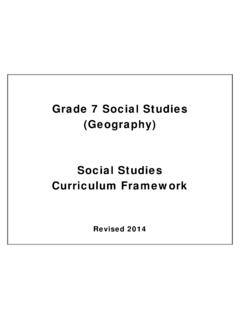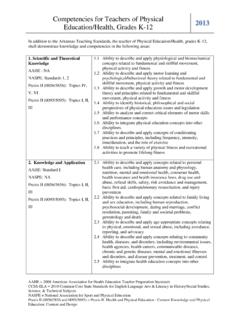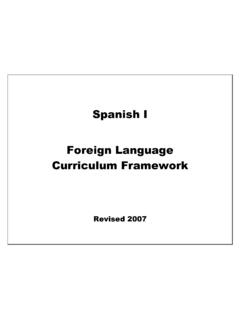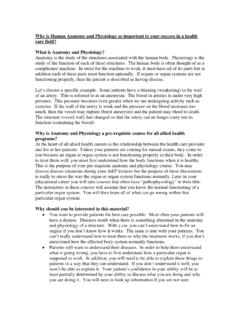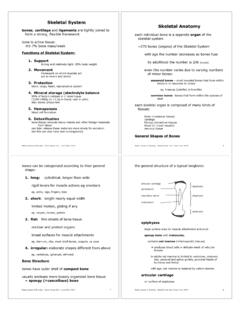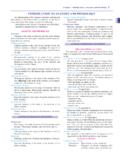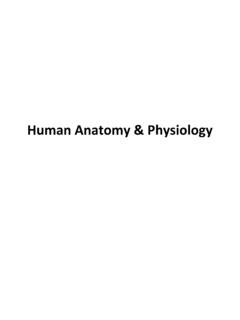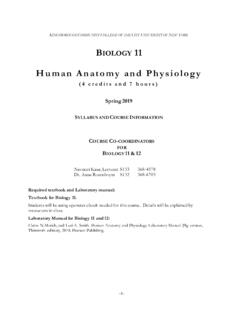Transcription of Human Anatomy and Physiology - State Board of …
1 Human Anatomy and Physiology 2016 2 Human Anatomy and Physiology Arkansas K-12 Science Standards Arkansas Department of Education 2016 Table of Contents Arkansas K-12 Science Standards How to Human Anatomy and Physiology Course Learning Progression Human Anatomy and Physiology Course Human Anatomy and Physiology Topics Topic 1: Topic 2: Structure and Function .. 13 Topic 3: Scale, Proportion, and Quantity .. 16 Topic 4: Stability and Change .. 19 Topic 5: Cause and Effect .. 21 Topic 6: Energy and Matter .. 24 Topic 7: Systems and System Models .. 27 Topic 8: Career Exploration with Engineering Contributors.
2 32 Notes: 1. Student Performance Expectations (PEs) may be taught in any sequence or grouping within a grade level. Several PEs are described as being partially addressed in this course because the same PE is revisited in a subsequent course during which that PE is fully addressed. 2. An asterisk (*) indicates an engineering connection to a practice, core idea, or crosscutting concept. 3. The performance expectation codes ending in AR indicate Arkansas-specific standards. 4. The clarification statements are examples and additional guidance for the instructor. 5. The assessment boundaries delineate content that may be taught but not assessed in large-scale assessments.
3 6. The section entitled foundation boxes is reproduced verbatim from A Framework for K-12 Science Education: Practices, Crosscutting Concepts, and Core Ideas. Integrated and reprinted with permission from the National Academy of Sciences. 7. The examples given ( ,) are suggestions for the instructor. 8. Throughout this document, connections are provided to the nature of science as defined by A Framework for K-12 Science Education (NRC 2012). 9. Throughout this document, connections are provided to Engineering, Technology, and Applications of Science as defined by A Framework for K-12 Science Education (NRC 2012). 10. Each set of PEs lists connections to other disciplinary core ideas (DCIs) within the Arkansas K-12 Science Standards and to the Arkansas English Language Arts Standards, Arkansas Disciplinary Literacy Standards, and the Arkansas Mathematics Standards.
4 3 Human Anatomy and Physiology Arkansas K-12 Science Standards Arkansas Department of Education 2016 Arkansas K-12 Science Standards Overview The Arkansas K-12 Science Standards are based on A Framework for K-12 Science Education (NRC 2012) and are meant to reflect a new vision for science education. The following conceptual shifts reflect what is new about these science standards. The Arkansas K-12 Science Standards reflect science as it is practiced and experienced in the real world, build logically from Kindergarten through Grade 12, focus on deeper understanding as well as application of content, integrate practices, crosscutting concepts, and core ideas, and make explicit connections to literacy and math.
5 As part of teaching the Arkansas K-12 Science Standards, it will be important to instruct and guide students in adopting appropriate safety precautions for their student-directed science investigations. Reducing risk and preventing accidents in science classrooms begin with planning. The following four steps are recommended in carrying out a hazard and risk assessment for any planned lab investigation: 1) Identify all hazards. Hazards may be physical, chemical, health, or environmental. 2) Evaluate the type of risk associated with each hazard. 3) Write the procedure and all necessary safety precautions in such a way as to eliminate or reduce the risk associated with each hazard.
6 4) Prepare for any emergency that might arise in spite of all of the required safety precautions. According to Arkansas Code Annotated 6-10-113 (2012) for eye protection, every student and teacher in public schools participating in any chemical or combined chemical-physical laboratories involving caustic or explosive chemicals or hot liquids or solids is required to wear industrial-quality eye protective devices (eye goggles) at all times while participating in science investigations. The Arkansas K-12 Science Standards outline the knowledge and science and engineering practices that all students should learn by the end of high school. The standards are three-dimensional because each student performance expectation engages students at the nexus of the following three dimensions: Dimension 1 describes scientific and engineering practices.
7 Dimension 2 describes crosscutting concepts, overarching science concepts that apply across science disciplines. Dimension 3 describes core ideas in the science disciplines. Science and Engineering Practices The eight practices describe what scientists use to investigate and build models and theories of the world around them or that engineers use as they build and design systems. The practices are essential for all students to learn and are as follows: 1. Asking questions (for science) and defining problems (for engineering) 2. Developing and using models 3. Planning and carrying out investigations 4. Analyzing and interpreting data 5.
8 Using mathematics and computational thinking 6. Constructing explanations (for science) and designing solutions (for engineering) 7. Engaging in argument from evidence 4 Human Anatomy and Physiology Arkansas K-12 Science Standards Arkansas Department of Education 2016 8. Obtaining, evaluating, and communicating information Crosscutting Concepts The seven crosscutting concepts bridge disciplinary boundaries and unit core ideas throughout the fields of science and engineering. Their purpose is to help students deepen their understanding of the disciplinary core ideas, and develop a coherent, and scientifically based view of the world. The seven crosscutting concepts are as follows: 1.
9 Patterns- Observed patterns of forms and events guide organization and classification, and prompt questions about relationships and the factors that influence them. 2. Cause and effect- Mechanism and explanation. Events have causes, sometimes simple, sometimes multifaceted. A major activity of science is investigating and explaining causal relationships and the mechanisms by which they are mediated. Such mechanisms can then be tested across given contexts and used to predict and explain events in new contexts. 3. Scale, proportion, and quantity- In considering phenomena, it is critical to recognize what is relevant at different measures of size, time, and energy and to recognize how changes in scale, proportion, or quantity affect a system s structure or performance.
10 4. Systems and system models- Defining the system under study specifying its boundaries and making explicit a model of that system provides tools for understanding and testing ideas that are applicable throughout science and engineering. 5. Energy and matter: Flows, cycles, and conservation- Tracking fluxes of energy and matter into, out of, and within systems helps one understand the systems possibilities and limitations. 6. Structure and function- The way in which an object or living thing is shaped and its substructure determines many of its properties and functions. 7. Stability and change- For natural and built systems alike, conditions of stability and determinants of rates of change or evolution of a system are critical elements of study.
